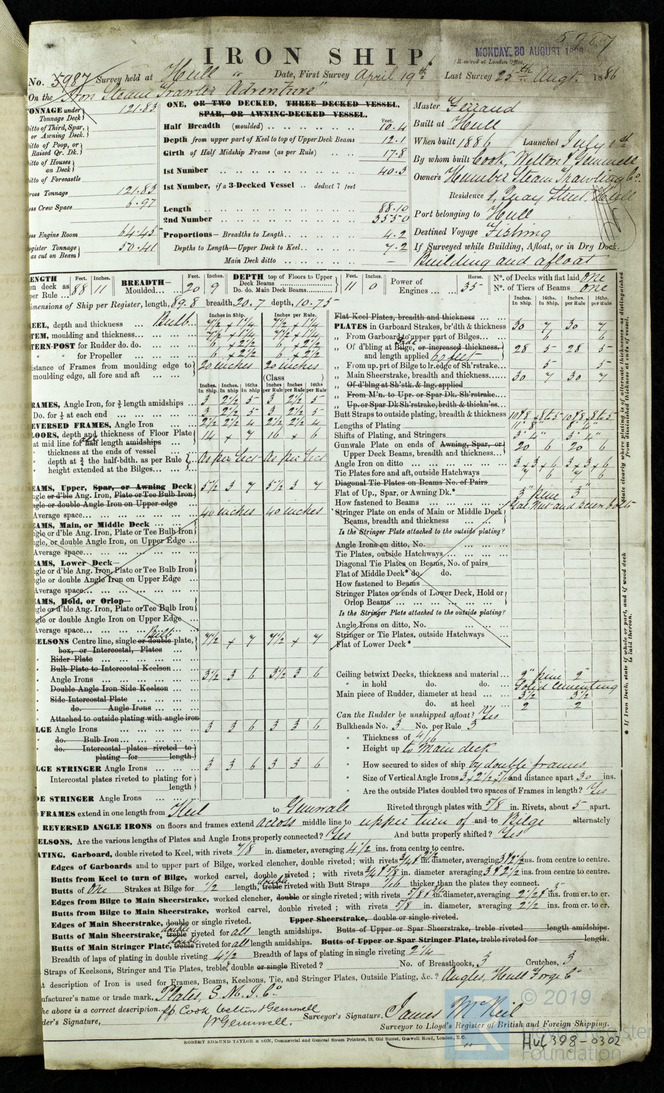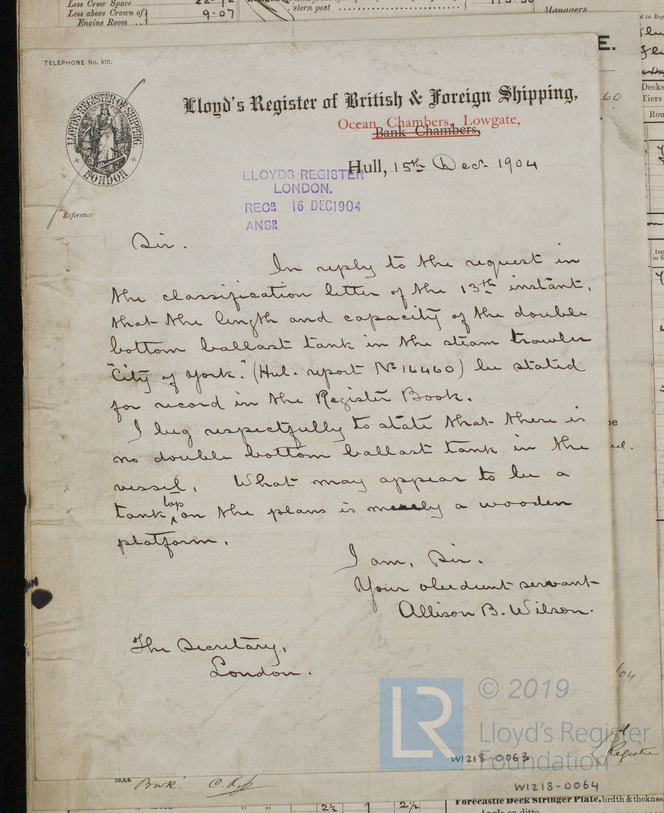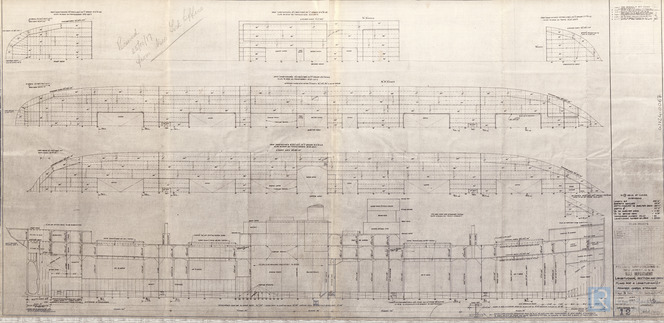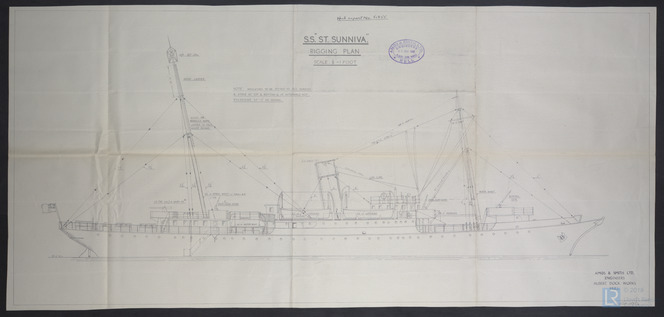1760
Foundation of the Society for the Registry of Shipping at Lloyd’s Coffee House, Lombard Street, London.
1764
The earliest surviving Register Book (1764-1766) includes survey data for many Hull vessels. Staff details and office addresses are not provided in early Registers. However, Hull was at this time one of the UK’s largest ports and this, coupled with the large number of Register entries, suggests that the Society had a local presence.
1784
The Register Book for 1784-1787 includes an A1 classification for Bethia, a collier built at Blaydes Shipyard on the River Hull and later renamed HMAV Bounty following purchase by the Admiralty. In 1789, disaffected crewmen seized control of the Bounty while on a voyage in the south Pacific, an infamous mutiny which would later inspire two films. You can listen to members of the Heritage & Education Centre team chat about the Mutiny on the Bounty films in the Maritime Films Podcast
Our postgraduate research base, the Blaydes Maritime Centre, is housed in the former home of the Blaydes family, situated adjacent to the site of their Shipyard.
1807
John Marshall, a Hull ship-owner and insurance broker, relocates to London. Marshall subsequently becomes an emigration agent, facilitating assisted passages to Australia. Marshall plays a role in trying to resolve the 'red book vs green book' dispute at Lloyd's Register. This dispute was the intense disagreement between underwriters and ship-owners over classification rules and lead to the formation of a rival Society. He publishes a report in 1826 but his recommendations prove contentious and the dispute carried on, with competing Registers published annually, until a resolution in 1833.
A biography of Marshall by Elizabeth Rushen has just been published by Anchor Books Australia.
1834
The Inquiry’s reform proposals are finally implemented. The Society for the Registry of Shipping is reconstituted as Lloyd’s Register of British and Foreign Shipping on 21 October and the publication of competing Registers comes to an end.
The first Register Book produced following the reconstitution lists 13 exclusive Lloyd’s Register surveyors for the entire UK, of whom two (James North and William A. Bingham) are responsible for Hull, Gainsborough, Goole, Selby Thorne and Grimsby. Hull’s significance is further emphasised by the inclusion of a member to represent the port on Lloyd’s Register’s newly-appointed General Committee.
Annual Registers show two Lloyd’s Register exclusive surveyors covering Hull and nearby ports.
1853
Lloyd’s Register’s long involvement with Earle’s Shipbuilding, Hull’s largest shipyard, begins in 1853 and continues until the company’s closure in 1931.
Ships are surveyed by Lloyd’s Register while under construction and in service, with many Earle’s vessels being awarded the class of ✠100A1. These include Navarino (1873), built for the Wilson Line, and T.S.S. Sir Richard Grenville (1931), the last vessel to leave the yard.
In 1900, Earle’s is purchased by the Wilson Line, Hull’s most famous shipping enterprise and at one stage the largest private ship-owning company in the world, with whom Lloyd’s Register also has strong links.
1881
Lloyd's Register invests in the Hull Dock Company to assist the development and improvement of Hull's port infrastructure. This investment comes at a crucial moment when the Company is preparing to construct St. Andrew's Dock, which opens in 1883 and adds 10.5 acres to the water area of Hull's port facilities. Although originally intended for the handling of coal, St Andrew’s Dock subsequently becomes home to the port's famous fishing fleet.
1906
The Hull trawler Viola is built in Beverley under Lloyd’s Register survey, forming part of the Hellyer fleet.
The Viola Trust is currently endeavouring to return the vessel from South Georgia to her home port. After restoration, it is intended that Viola, the oldest surviving steam trawler in the world with her engines intact, will be exhibited at the regenerated North End Shipyard alongside the Arctic Corsair, Hull’s last surviving sidewinder distant-water trawler, built in 1960 and now included on the National Register of Historic Vessels.
1956
The annual Register Book indicates that Lloyd's Register has moved its Hull base from Ocean Chambers to the recently-completed Festival House at 93 Jamieson Street, where a name plaque remains today, although these premises are no longer occupied by Lloyd's Register.
1957
Fishing remains a key industry for the city of Hull but is still a very hazardous occupation.
In 1951, the Sea Fish Industry Act had established the White Fish Authority (WFA), whose function was to reorganize, develop and regulate all aspects of the white fish industry. The WFA’s remit included the improvement of working conditions and in 1957 it makes funding aid for trawler construction conditional upon Lloyd’s Register classification.
1960
The Arctic Corsair, arguably Hull’s most famous distant-water trawler, is built for the Boyd Line under Lloyd’s Register survey at the Cook, Welton & Gemmell shipyard in Beverley.
In many ways, the subsequent history of this vessel will mirror the decline of Hull’s fishing industry.
After setting a world record for landing of cod and haddock in the White Sea in 1973, the Arctic Corsair is holed below the waterline during a collision with an Icelandic patrol vessel in the Cod Wars of 1976. Following the Cod Wars, the Arctic Corsair is converted to midwater trawling in 1978, but is laid up for long periods.
1968
Triple Trawler Tragedy - Between 11 January and 4 February, three Hull trawlers go down in extreme conditions off the coast of Iceland. Although built and maintained under Lloyd’s Register survey with a ✠100A1 classification, the St. Romanus, Kingston Peridot and Ross Cleveland capsize due to a fatal combination of icing up and hurricane force winds. One crew-member from the Ross Cleveland is the only survivor as fifty eight local men lose their lives.
The Board of Trade establishes a Committee of Inquiry into Trawler Safety on 5 March 1968, to which Lloyd’s Register and industry bodies including the WFA are invited to submit evidence. The Committee’s Report, published in May 1969, makes extensive recommendations on the construction of trawlers, safety and fishing equipment.
Hull in the Present Day
With support from Hull City Council, the port’s last surviving sidewinder distant-water trawler opens to the public in 1999 as a floating museum moored on the River Hull, following restoration by volunteers. Arctic Corsair is currently undergoing extensive refurbishment at Alexandra Dock. The vessel will then be moved to a new permanent dry dock in the redeveloped North End Shipyard, as part of the Hull: Yorkshire’s Maritime City Project.
Hull: Yorkshire's Maritime City is a five-year, £27.4 million programme and one of the North of England’s largest heritage projects. It will explore and celebrate the many facets of the port’s seafaring past.
Lloyd’s Register still maintains an active presence in Hull – their office is now located on the north bank of the Humber estuary at Waterside Business Park, Hessle.
The Thomas Chapman PhD scholarships, funded by the Lloyd’s Register Foundation and based at the Blaydes Maritime Centre at the University of Hull, now add to this historical relationship with the city. The Blaydes Maritime Centre is housed in the former home of the Blaydes family, situated adjacent to the site of their Shipyard.
As our research progresses, we look forward to discovering more about Lloyd’s Register’s uncharted Hull connection.
About the Authors
This online exhbition is due to the research of Peter Phillipson and Sam Wright. They are Lloyd's Register Foundation Thomas Chapman PhD Scholars based at the University of Hull. Below they describe what gives them the passion to pursue careers in maritime history.
Peter Phillipson: Ships and shipbuilding have always fascinated me, which may be due to the influence of my Glasgow-born father or because I grew up on Tyneside. I’m a retired engineer so I appreciate the technical challenges involved in confronting the forces of nature. However, my fascination derives from more than professional interest: ships are unique cultural and historic artefacts, with individual identities and life stories.
Sam Wright: My interest in maritime history began on childhood holidays to the Lake District which, at my persistent request, always involved a cruise on Windermere. From there, my fascination with ships and mankind’s relationship with the maritime world grew, and university allowed me to investigate other topics such as port-cities and how such places were shaped by their relationship with the sea.





